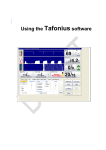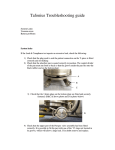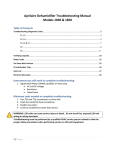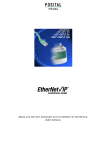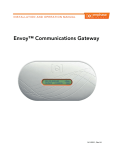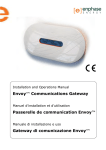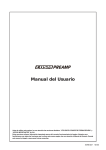Download DOCA4962 Tafonius Junior User Guide v10Mar2011
Transcript
Tafonius Junior J2 A USERS GUIDE v10Mar2011 Tafonius Junior – A User Guide Notes: Printed: 28/Mar/11 Page 2 of 19 DOCA4962 Tafonius Junior – A User Guide Table of Contents An Overview .........................................................................................................................5 Junior sans gas ..............................................................................................................5 Junior with gas ...............................................................................................................7 Controller Boot Up Sequence............................................................................................9 INITIALISING DRIVE CONTROL ..............................................................................9 CHECKING DRIVE VOLTAGE: 27.9 14.0 13.9.....................................................9 VOLTAGES ALL OK..................................................................................................9 APPLYING POWER TO VIX DRIVE:.........................................................................9 SETTING COMMUNICATIONS TO DRIVE ...............................................................9 SETTING COMS RATE TO 19200 ............................................................................9 COMMS - SET AT 19200 BAUD - OK ...................................................................9 NOW TESTING VIX DRIVE INTEGRITY ...................................................................9 INITIAL DRIVE CHECK OK .......................................................................................9 INITIALISATION COMPLETE ...................................................................................9 CHECKING FOR PC CONNECTION ......................................................................10 Manual Leak Testing .......................................................................................................11 Initialising the Piston .......................................................................................................11 The Control Screen .........................................................................................................12 1) Status and message information .............................................................................12 2) Piston Graphic and Information ...............................................................................12 MWPL .....................................................................................................................12 ASSIST ...................................................................................................................12 3) Resultant Ventilation values ....................................................................................13 4) Patient Ventilator settings & Measured values.........................................................13 Ventilator Controls...........................................................................................................13 Setting Values using the control knobs – Change & Commit .......................................13 Control setting validation .............................................................................................13 THE CONTROL KNOBS .........................................................................................13 Tidal Volume: The range is 0.1L to 20.0L in 0.1L increments...........................13 Respiratory Rate: The range is 1 to 30 breaths per minute in 1 BPM increments. 13 Inspiratory Time: The range is 0.5 to 4.0 in 0.1 second increments..................13 MWPL: The range is 10cm H2O to 80cm H2O in 1 cm increments. .................13 OTHER CONTROLS ...............................................................................................13 Assist: The range is 1 lpm to 200 lpm inspiratory flow, 1 lpm increments. ........13 In STANDBY mode..............................................................................................13 In IPPV mode ......................................................................................................14 CPAP/PEEP The range is 0 to 50 cmH2O. in 1 cmH2O increments.................14 In Standby Mode .................................................................................................14 In Ventilator Mode ...............................................................................................14 Dump valve button...............................................................................................14 Controls on the Anesthesia Machine Side ...................................................................14 Oxygen Flowmeter ..................................................................................................14 Air Flowmeter ..........................................................................................................15 N2O Flowmeter ........................................................................................................15 Junior and Spontaneous Breathing ..............................................................................15 View the Piston as a “Virtual bag .................................................................................15 Dictating the size of the “Virtual Bag”...........................................................................15 Ventilation measurements during Spontaneous Mode.................................................16 Junior and IPPV ...........................................................................................................16 Printed: 28/Mar/11 Page 3 of 19 DOCA4962 Tafonius Junior – A User Guide Warning Messages – Alerts and Alarms..........................................................................17 Alerts...........................................................................................................................17 BATTERY1 LOW VOLTAGE and/or ........................................................................17 BATTERY2 LOW VOLTAGE ...................................................................................17 MAX PRESSURE EXCEEDED LIMIT......................................................................17 LOW SYSTEM RESERVE VOLUME.......................................................................17 CYLINDER EMPTY/OUT OF RESERVE .................................................................17 SYSTEM FULL ........................................................................................................17 PISTON POSITION INFO ERROR ..........................................................................17 Alarms.........................................................................................................................18 * LOW BREATHING SYSTEM PRESSURE *........................................................18 * OXYGEN SUPPLY PRESSURE LOW * ..............................................................18 * BATTERY 1 CRITICALLY LOW * and/or.............................................................18 * BATTERY 2 CRITICALLY LOW *........................................................................18 * ENCODER BOARD HAS FAILED *.....................................................................18 * CHECK POSITION SENSORS * .........................................................................18 * RD VACUUM FAILURE * ....................................................................................18 Technical Specifications:.................................................................................................19 Printed: 28/Mar/11 Page 4 of 20 DOCA4962 Tafonius Junior – A User Guide An Overview There are two versions of Junior . One with a circle system and gas controls the other is a ventilator only for use with another gas machine. Junior sans gas Shown here with a Matrx by Midmark VML gas machine head. Optional IV Pole Control Panel and Display Optional VML Scavenging Flowmeter Machine Name (Serial Number) Servo Motor Connection to Ventilator Piston Cylinder 8” (200mm) Locking Casters Printed: 28/Mar/11 Page 5 of 19 DOCA4962 Tafonius Junior – A User Guide RCD / GFCI mains breaker Scavenging flowmeter Mains fuses Vacuum / EVAC gas fitting Cuff inflation syringe / ET tube holding bracket Power cord / Gas hose hanging straps Vacuum Sensing Port Vacuum Inlet Port Piston Cylinder Single Bottom Pan Lighted mains plug (USA type only) Locking Front Casters Dump Valve button qVGA Display Assist button CPAP / PEEP button Ventilate / Standby button Name / SN Soft Power Switch TV, RR, It & MWPL controls Not used on this model Printed: 28/Mar/11 Page 6 of 19 2” (54mm) Breathing Circuit connection port DOCA4962 Tafonius Junior – A User Guide Junior with gas This version has the same circle system as Tafonius as well as mounting space for two vaporizers and two flowmeters, oxygen and air. Only the additional features are labelled below. Breathing system pressure manometer Patient Wye Oxygen supply pressure gauge Oxygen flowmeter Oxygen flush button 2” (54 mm) Breathing tubes Vaporizer mounting locations Inspiratory/Expiratory Valve Block Absorber pan Double bottom pan Printed: 28/Mar/11 Page 7 of 19 DOCA4962 Tafonius Junior – A User Guide Turning Junior On Press the soft ON/OFF control button (1). The Control screen (2) and the soft ON/OFF button immediately illuminate. There is a single output (beep) from the speaker and the 2 1 Control screen shows “PUSH ANY KNOB FOR PRESSURE SENSOR SETUP”. The user has 2 seconds to push any of the rotary knobs to enter the Pressure Sensor setup screen. Experience over the last 4 years has indicated that this feature will very rarely be needed or used. If there is a discrepancy between the two offset values seen on the screen below, it usually indicates some problem other that pressure sensor drift. Most frequently you’ll find water in the pressure sampling line. It is recommended that you blow out the pressure sensing line on a regular basis. To do this remover the sensing line from the underside of the main control box and flush the line out with a syringe. You will need a female coupler or you could use a stopcock to connect the syringe to the sampling line as shown here. Printed: 28/Mar/11 Page 8 of 19 DOCA4962 Tafonius Junior – A User Guide Should one chooses to enter the Pressure Sensor Setup routine there are two options: • • Pressing any of the four control knobs will use the factory default value as shown. Pressing the RUN / IPPV button will use the actual current measured value, which is constantly being updated on the screen. The chosen value is stored in the non-volatile memory and will remain unchanged until the Pressure Sensor Setup routine is run again. Use the Pressure Sensor setup routine if there is piston movement when no patient is attached the wye piece is not capped AND you have flushed the sensing line. The initialisation procedure continues with the boot-up sequence. Controller Boot Up Sequence After providing the option for pressure sensor setup, the following sequence occurs: INITIALISING DRIVE CONTROL At this stage the servomotor drive, the ViX Drive, is presumed un-initialised and its initialisation begins. The software version is displayed at the bottom left hand corner of the screen. The 24 volt supply line feeding the motor drive as well as the individual battery voltages are measured and its value displayed on the screen e.g. CHECKING DRIVE VOLTAGE: 27.9 14.0 13.9 If the supply voltage, 27.9 above, is less than 16.0 volts, then the shutdown procedure starts as there is insufficient battery power to safely run the system. In this instance you should connect the mains power and re-start the system. If the voltages are sufficient one beep is heard as the screen displays the following. VOLTAGES ALL OK APPLYING POWER TO VIX DRIVE: The power to the servomotor drive is applied and tested. Then after successful communications have been established with the ViX drive, two beeps are heard and the following is displayed. SETTING COMMUNICATIONS TO DRIVE SETTING COMS RATE TO 19200 COMMS - SET AT 19200 BAUD - OK The servomotor drive is then initialised. The next stage checks the motor drive Integrity as the following is displayed NOW TESTING VIX DRIVE INTEGRITY Assuming all is well then the message INITIAL DRIVE CHECK OK is displayed, followed by a string of ones and zeros on the screen. If at any time during this initialisation procedure an error is detected then an error message is displayed and the whole system shuts down. If everything is as it should be then the screen shows INITIALISATION COMPLETE Printed: 28/Mar/11 Page 9 of 19 DOCA4962 Tafonius Junior – A User Guide At this stage the Control Screen looks like the screen below. The controller next displays CHECKING FOR PC CONNECTION and waits while it checks for the presence of a USB attached device. If the USB device is detected the display changes (below left) to offer you the chance to do a manual leak test. The operator has two seconds to push any of the four control knobs to enter the leak test routine. After two seconds the display changes to (below right) ) and waits for the Tafonius software to boot up and take over control. Should the Tafonius software not claim control within two minutes auxiliary controller proceeds with piston initialisation and displays instructions to DISCONNECT THE PATIENT AND PUSH THE RUN BUTTON. If the USB device is not detected, as is the case when running without a PC monitor the auxiliary controller will again change the display (to below left) offering to enter the leak test routine. After two seconds elapses without any button being touched the display goes directly to the DISCONNECT THE PATIENT AND PUSH THE RUN BUTTON screen seen on the next page. Printed: 28/Mar/11 Page 10 of 19 DOCA4962 Tafonius Junior – A User Guide Manual Leak Testing Should one press a control button within the two-second window in either of the scenarios above the machine will display the screen below right. Follow the instructions on the screen. Turn on the gas flow to bring the breathing system pressure up to 20 cmH2O. Adjust the flow rate to hold the pressure steady at 20 cmH2O. The flow observed on the flowmeter is the leak rate at that pressure. Initialising the Piston Before Junior can be used the system needs to locate the zero position, the bottom of travel, of the piston. The RUN button will be flashing, after the boot sequence, while waiting for the user. Make sure there is nothing attached to the Y-piece before pushing RUN the button. Once the button is pushed the screen shows the message MOVING PISTON TO ZERO. During this piston movement the airway pressure is monitored. If there is a patient attached or an obstruction to airflow then the following message appears: ERROR. PRESSURE TOO HIGH DISCONNECT PATIENT THEN PUSH RUN BUTTON Clear the obstruction or remove the patient before continuing. There are 2 other possible reasons why the initialisation procedure may be interrupted: The first is that the cylinder is not closed properly. The second is that the vacuum surrounding the piston is too low. In either of these instances warning messages will appear alerting you to the cause and remedy of the interruption. Once the piston reaches the bottom of its travel, a zero reading is taken and ZEROING PISTON POSITON is displayed briefly. Three beeps are heard and the control screen is displayed, see below. The piston is at the very bottom waiting for the user to pre-fill the system with oxygen and anaesthetic for induction. Junior is ready for use. Printed: 28/Mar/11 Page 11 of 19 DOCA4962 Tafonius Junior – A User Guide The Control Screen 1 2 3 4 1) 2) 3) 4) Status and message information Piston Graphic and information Resultant Ventilation values Patient Ventilator settings & Measured values Before continuing here is an explanation of what you see on the Control screen. It is divided into 4 main regions: 1) Status and message information Area 1 shows status information on the system batteries, whether the machine is running on mains or battery power, the software version, the vacuum level around the piston and also displays any error or warning messages. The battery information shows the actual voltages of the two batteries used in Junior and whether or not they are being charged. When there are no warning or error messages, the name junior is displayed in this area. 2) Piston Graphic and Information Area 2 shows a representation of the piston. The dark area represents the volume of gas under the piston and the numerical value at the top of the list to the right displays the amount in litres. See the photo above right as the piston in the photo above left is at the bottom with 0.0 litres under it. The piston position and volume are constantly updated showing the position of the piston at all times. Two asterix (* *) will appear at the top of the piston area whenever the Dump Valve, the electric pop-off valve, is open. Below the volume display in litres are three settings that are not otherwise always display on the screen. MWPL The Maximum Working Pressure Limit in cmH2O is generally seen above the right most control knob used to set its value however it will not be displayed there when using the Assist Mode. The MWPL is set as a high pressure safety limit the value of which is continuously compared to the breathing system pressure. Junior is a volume or time cycled ventilator so the MWPL does NOT set how high the pressure will go but if the pressure should reach the set level the machine will alarm immediately, terminate inspiration and switch to the expiratory phase of the breathing cycle. ASSIST The ASSIST function is a mechanism that detects a patient’s efforts to breathe then gives an assisted breath if that effort meets or exceeds a user set minimum level. The value next Printed: 28/Mar/11 Page 12 of 19 DOCA4962 Tafonius Junior – A User Guide to the text ASST is the level of inspiratory flow, in liters per minute, the patient must generate or exceed to trigger and assisted breath. 3) Resultant Ventilation values Area 3 shows the values that result from the settings of the independent variables Tidal Volume, Respiratory Rate and Inspiratory Time. The dependent variables displayed in this area are Minute Volume (MV) in liters per minute (lpm), Inspiratory Flow Rate (IF) in lpm, I:E ratio and expiratory time (ET) in seconds. These are updated whenever a ventilation parameter is changed. This feature allows the user to see how other parameters are affected by the change being made. One can also “set” a dependent variable. For example you can set the MV by changing the TV and or the RR and watch the resulting effect on the MV display. Similarly one could “set” the I:E Ratio by changing the RR and or the I-time. 4) Patient Ventilator settings & Measured values Area 4 shows the set values for Tidal Volume (TV), Respiratory Rate (RR), Inspiratory Time (IT) and Maximum Working Pressure Limit (MWPL). The values in parentheses above these settings are the measured values taken during spontaneous breathing. Ventilator Controls Junior’s ventilator is controlled via the 4 control knobs below the Control screen, the RUN/IPPV button, Assist button, CPAP/PEEP button, Oxygen Flush button, Dump Valve button and the soft power ON/OFF switch. Setting Values using the control knobs – Change & Commit The process of setting any value uses the concept of “Change & Commit” Turning the Tidal Volume knob for example will change the value and a small asterisk will appear next to the changed value. To commit this new value push in the Tidal Volume knob (or any of the 4 knobs) until a single beep is heard. The asterisk disappears and the new value is held on the screen. If the value is not committed by pressing a control knob then after 4 seconds the setting will revert to the original value. This process prevents accidental or inadvertent changing of ventilation parameters. Control setting validation There are 4 control knobs sitting directly beneath the display of the parameter they control. When adjusting any of the values comparisons are made with existing settings to ensure that settings which exceed the capabilities of the machine are not made. For example if the Inspiratory Time is set to 1.0 seconds then it will be impossible to set the Tidal Volume to anything greater than 17.3L since this would otherwise exceed the machines capacity to deliver the inspiratory stroke at 1000 litres per minute. Similarly a Respiratory Rate of greater than 17 cannot be set if the Inspiratory time is 3.0 seconds and the tidal volume is 17.3L because this would require an expiratory flow rate of over 1000L per minute – if the RR was more than 15 then the Expiratory time would be less than 1 second. THE CONTROL KNOBS Tidal Volume: The range is 0.1L to 20.0L in 0.1L increments. Respiratory Rate: The range is 1 to 30 breaths per minute in 1 BPM increments. Inspiratory Time: The range is 0.5 to 4.0 in 0.1 second increments. MWPL: The range is 10cm H2O to 80cm H2O in 1 cm increments. OTHER CONTROLS Assist: The range is 1 lpm to 200 lpm inspiratory flow, 1 lpm increments. In STANDBY mode In STANDBY mode, spontaneous breathing, this effort level can be set but is not active until the IPPV/RUN button is pushed. To use the ASSIST function, press the ASSIST button once, the ASSIST button will flash slowly and the MWPL legend on the Control screen will Printed: 28/Mar/11 Page 13 of 19 DOCA4962 Tafonius Junior – A User Guide be replaced with the text “SENS” for sensitivity followed by a value e.g. 60 LPM. This value of 60 litres per minute is the inspiratory flow rate that the patient must meet or exceed in order to trigger the next IPPV stroke. This will not happen unless the ventilator is in IPPV mode. Pressing the RUN/IPPV button will cause the IPPV button to be lit and the ASSIST button will then remain lit continuously. In IPPV mode Alternatively the ASSIST mode can be chosen when the patient is receiving IPPV. In this case the ASSIST mode will be lit continuously to show that the ASSIST mode is active. In this state the ventilator is waiting for an effort from the patient. If this effort level is not met within the time required for 3 breath cycles based on the period dictated by the set RR a mandatory breath is given. If the patient triggers a breath then the timing of the mandatory breath is reset. In either case, the delivered breath will be based on the set TV and I-time. Pressing the RUN/IPPV button will return the ventilator to spontaneous mode and cancel the ASSIST function. This is a new feature and we currently have no guidelines on values to set. The software offers a range of between 1 LPM and 200 LPM as trigger values. We would welcome feedback on the settings found useful or normal in practice. CPAP/PEEP The range is 0 to 50 cmH2O. in 1 cmH2O increments In Standby Mode CPAP or Continuous Positive Airway Pressure can he applied during spontaneous breathing. With CPAP patients inspire and expire normally with no added effort, although the end expiratory pressure is elevated to the CPAP setting. This aids in maintaining open alveoae. The airway pressure is held constant during all phases of spontaneous breathing. In Ventilator Mode During IPPV the term PEEP or Positive End Expiratory Pressure applies. Ventilating pressures rise during the Inspiratory phase as normal, but are allowed only to fall as far as the PEEP setting during expiration. Dump valve button The dump valve button affords you manual control of the electronic pop-off valve. This is useful when you want to empty the “bag” into the scavenging system at the end of a case or to quickly drop the anaesthetic concentration by replacing the gas under the piston with anaesthetic free oxygen. To do this first apply 2 cmH2O of PEEP then push the dump button. The valve will open for a minimum of 1 second or if held for 1 second after the button is released. After the dump valve closes use the O2 flush button to refill the cylinder. Controls on the Anesthesia Machine Side These include the oxygen flowmeter, air and N2O flowmeters if fitted, the scavenging flowmeter and the dump valve switch. Oxygen Flowmeter The oxygen flowmeter has a 0 -10 lpm scale but considerably more flow can be delivered when the ball is off the top of the scale. Use this flowmeter as you would on any other anaesthesia machine. Printed: 28/Mar/11 Page 14 of 19 DOCA4962 Tafonius Junior – A User Guide Air Flowmeter An optional air flowmeter with either a yellow knob for the US or a black and white knob for most other countries may be installed on your machine. This allows the user to be able to adjust the FiO2 delivered to the breathing system. The nomogram shown below can be used as a guide for setting the FiO2 but it is easy to remember that: Equal flows of air and oxygen yields 60% O2 3 times as much air as oxygen yields 40% O2 3 times as much oxygen as air yields 80% O2 N2O Flowmeter Although the use of N2O is much a thing of the past this option is still available but should never be used without a working oxygen analyzer. Junior and Spontaneous Breathing View the Piston as a “Virtual bag When the ventilator is idle and a patient is connected, the system behaves like a ‘perfect’ bag. By a perfect bag we mean that when the patient breathes out there is no expiratory resistance and when the patient breathes in there is no inspiratory resistance. This action is possible because the airway pressure is sensed at the centre of the Y-piece. As soon as a pressure deviation in excess of 0.5 cmH2O from the ambient pressure is detected the piston is moved so as to negate this pressure change. If the patient breathes out then the piston withdraws, effectively filling. If the patient inspires then the piston moves down, effectively emptying. Because a motor drives the piston it is the motor that overcomes the resistances of any piping, valving or soda lime. To the patient it feels like breathing to room air with no resistance. Dictating the size of the “Virtual Bag” The size bag you use on your anaesthesia machine depends on the size of the patient. The breathing bag must be large enough to hold the largest size breath the patient may take. But it should not be overly large because the excess volume increases the time constant of the breathing system making it take longer for changes in vaporizer settings or the FiO2 setting equilibrate and take effect. The tidal volume and the concept of fixed buffer volumes control the size of the “Virtual Bag”, the volume under the piston, in Junior . There are two fixed buffer volumes; an upper and a lower. The lower buffer volume is 1.5L and the upper buffer volume is 1.0L. These volumes are constant and are added to the tidal volume setting to determine the minimum “Bag” size and to create upper and lower volume limits. The upper volume limit = Lower Buffer + Tidal Volume + Upper Buffer. The lower volume limit = Lower Buffer Whenever the piston volume exceeds the upper limit, gas is removed from the system. If the piston volume falls below the lower limit then gas is added to the system. Example 1: A 300kg patient breathing spontaneously Rule of thumb would suggest setting the TV control to 3.0L Printed: 28/Mar/11 Page 15 of 19 DOCA4962 Tafonius Junior – A User Guide The upper limit of the piston volume is then 1.5 + 3.0 + 1.0 L = 5.5L The lower limit of the piston volume is 1.5L (it is always 1.5L) If the patient has just been induced, initial gas flow rates may be of the order of 5-10L per minute. This will tend to fill the system. Whenever the piston volume exceeds the 5.5L limit the piston stops rising and some gas will be discharged from the system through the electronically controlled Dump Valve. Whenever the piston volume falls below 1.5L, say with a big inspiratory effort from the patient, then an extra 1.0L of oxygen will be added to the system through the vaporiser automatically. In this manner the system is kept at a fairly constant volume of around 5.5L. If the breathing of the patient is erratic and the piston repeatedly enters the upper and lower limits then it would be appropriate to increase the tidal volume setting until the patient settled, this would increase the “Bag” size temporarily. The tidal volume must be returned to the desired setting when IPPV is required otherwise the extra volume will be delivered to the patient. Example 2: A 300kg patient being ventilated with IPPV Tidal volume set to 3.0L. The upper and lower limits are the same as before: 5.5L and 1.5L respectively. The tidal volume setting is then increased to 4.0. This increases the upper limit to 6.5L so the piston is allowed to rise to that level by virtue of the continuously flowing fresh gas flow into the system. Ventilation measurements during Spontaneous Mode In Spontaneous or Standby mode the piston position is constantly monitored and will display patient breathing parameters when regular cyclic movements are detected. The values are updated at the beginning of each expiratory phase and show the values for the last breath cycle. The values in parentheses above the Tidal Volume, Respiratory Rate and Inspiratory Time legends are measurements of the respective parameter. The value above the MWPL legend is the maximum airway pressure measured during the last breath cycle. The dependant parameters such as minute volume, inspiratory flow etc are not affected by these measurements and reflect only the settings of the control values. Junior and IPPV Changing between spontaneous breathing mode (standby) and ventilation mode is very simple and can be done at any time. As soon as the IPPV / RUN switch is pressed it will illuminate to indicate machine is in IPPV mode and immediately an inspiratory phase begins delivering the tidal volume as set by the TV control. To stop IPPV at any time, simply press the IPPV / RUN switch again. The switch light will go out and the unit will return to standby mode. In IPPV mode the tidal volume is delivered in the time set by the Inspiratory Time setting (see Control Setting Validation for an explanation of how settings are restricted). After the tidal volume has been delivered the expiratory phase begins. In the expiratory phase the piston immediately behaves like a “Bag” and allows the patient to breathe out raising the piston as it does. The piston stays in this state until the end of the expiratory time when the inspiratory phase begins again and the piston is driven downwards delivering gas to the patient again. At all times the piston image on the screen shows the position and actual volume under the piston. Printed: 28/Mar/11 Page 16 of 19 DOCA4962 Tafonius Junior – A User Guide Warning Messages – Alerts and Alarms There are two levels of warning messages alerts and alarms. Alerts These messages are accompanied by an initial 2-second audible beep but are then silent. A flashing text message will appear on the screen in Area 1, where the junior logo is normally displayed. Alerts are non-critical events encountered during normal operation. To clear an alert manually press and hold any of the 4 control knobs until two beeps are heard. Here is a list of the alerts. BATTERY1 LOW VOLTAGE and/or BATTERY2 LOW VOLTAGE The indicated battery has a low voltage. This is normally because the machine is being operated without the mains connected. Connect the mains supply and make sure the RCD or GFCI switch at the back of the machine is on. The alert will stay on screen until cleared. Unless the problem has been resolved the alert will return. MAX PRESSURE EXCEEDED LIMIT The airway pressure exceeded the setting of the Maximum Working Pressure Limit. The Alert will stay on screen until cleared manually. LOW SYSTEM RESERVE VOLUME The piston has entered the lower buffer volume of 1.5L. If this is during an active inspiratory phase then gas will automatically be added through the vaporiser. If the vaporiser is off then gas will still be added, but without agent. When the piston moves out of the lower buffer zone then the alert will self clear. CYLINDER EMPTY/OUT OF RESERVE The piston is at the lower most position, i.e. zero volume. If this is during the inspiratory phase then the full tidal volume will not have been delivered. When the piston moves away from the zero point the alert will self clear. SYSTEM FULL The piston is at the most full position i.e. maximum volume. The Dump Valve will be opened to allow gas to escape and prevent pressure building up. When the piston moves away from the top point the alert will self clear. PISTON POSITION INFO ERROR The piston position reported from the motor is incorrect. This is usually transient and is selfcorrecting. Any permanent loss of position information will result in an alarm condition. The alert will stay on screen until cleared manually. Printed: 28/Mar/11 Page 17 of 19 DOCA4962 Tafonius Junior – A User Guide Alarms These messages are accompanied by a repeating intermittent beep of approximately one second duration. A flashing text message will appear on the screen in area 1, where the Junior logo normally sits. Alarms are critical events that have serious implications for the efficient ventilation or support of the patient. Each alarm that is shown on the screen will have an asterisk at each end of the text, e.g.: * OXYGEN SUPPLY PRESSURE LOW * To clear an alarm manually press and hold any of the 4 control knobs until two beeps are heard. Here is a list of the alarms. * LOW BREATHING SYSTEM PRESSURE * This Alarm occurs when, at the end of an inspiratory phase during IPPV or Assist, a maximum pressure of 2 cmH2O has not been reached. This can occur when the patient has become disconnected from the system. It can also occur when the patient takes a breath at the same time as the ventilator delivers a breath. The Alarm will continue until either a pressure in excess of 2cm H2O is registered during an inspiratory phase OR the alarm is cleared manually. * OXYGEN SUPPLY PRESSURE LOW * The piped oxygen pressure, whether it is from the hospital supply Line, or from the Ecylinders has fallen below 40 psi. This alarm can only be cleared by connecting a source of oxygen with a pressure greater than 40psi. * BATTERY 1 CRITICALLY LOW * and/or * BATTERY 2 CRITICALLY LOW * Either one of the batteries voltage has reached the critical level. Below this level ventilator function may be severely compromised, particularly with regard to piston movement and the action of the Dump Valve. The ventilator must be connected to the mains supply immediately. * ENCODER BOARD HAS FAILED * The circuit board for the front control knobs has failed to respond to the main controller. It will not be possible to change any of the ventilation settings. This is a critical error and the patient should be changed to manual ventilation. * CHECK POSITION SENSORS * The lower or upper position sensor has been moved or is faulty. Check the alignment marks of the position sensors on the piston actuator. Without a lower position sensor the ventilator cannot be initialised and will not run. The patient should be changed to manual ventilation. * RD VACUUM FAILURE * The vacuum level in the double diaphragm has fallen below a critical level. Continued use of the ventilator will result in severe damage to the piston assembly. The vacuum level must be restored before ventilation is re-enabled. Check the connections of the hose at the vacuum port on the ventilator cylinder. Until the vacuum has been restored the patient should be changed to manual ventilation. Printed: 28/Mar/11 Page 18 of 19 DOCA4962 Tafonius Junior – A User Guide Technical Specifications: GENERAL Size: Weight: Construction: 51” x 30” x 24” , height x depth x width ???kg sans gas, ???kg with gas Powder-coated stainless steel and aluminium ELECTRICAL Power Input: Power consumption: Operational voltage: Battery Charging: Printed: 28/Mar/11 90-240v AC 50/60Hz Universal input 400W max 12v/24v DC Sealed Lead Acid (SLA) Batteries In-built lead-acid chargers @ max 5A charge Page 19 of 19 DOCA4962



















